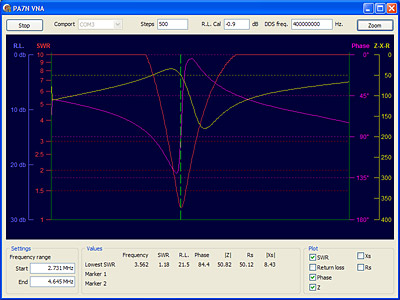
miniVNA

miniVNA is a small Vector Network Analyser. It has no buttons and no display. It should be connected to a PC via the USB bus. With the miniVNA comes software written in Visual Basic. Although the hardware is great I didn't like the software. The user interface is not very flexibel (you can't scale it for example) and the UI doesn’t respond very well. As a professional software developer I'm trying to write a better program.
The current version is written in Delphi. But I'm planning to write a Linux version in C++ based on KDE/QT. The Windows version is closed source software as I use some libraries I can not distribute. The Linux version will be open source.
On this page you can download the first version of my miniVNA software. It is still an early alpha version so don't expect to much. There is still a lot to do. For example the reflection mode, cable length, frequency generator, calibration, Q-measurement, etc. But if you would like to test it you can download the executable. Just put it in some directory, create a shortcut to your desktop and run it. You can always send me your comments via erwin at pa7n dot nl. But don't expect me to include your great ideas next week ;-)
Update: 28-12-2011
I have made some improvements. I added measuring L, C and Q. There is also A new calculator to calculate L or C. On the DUT port you can put A known C in series with an unknown L (or vice versa) and calculate L by putting marker1 on the resonance frequency. You have resonance when Xs is almost zero and/or when there is a phase turning.
Update: 05-12-2012
The PA7N miniVNA project is now A open source project. You can download the source code from Github. Feel free to fork the project, create some modifications, pull requests. Have Fun! The source compiles with Delphi 2007 and Lazarus 1.0 / FPC 2.6.
Source on GitHub